Natural Pest Control in the Garden – Get Rid of 20 Top Pests
This post may contain affiliate links. Read my full disclosure here.
Are you looking for natural pest control options for the garden? From ants to squash vine borers, we’ll cover natural pest control for 20 common garden pests to keep your garden healthy and save the harvest.
Like many home gardeners, I started growing my own fruits and vegetables in part to avoid the toxic chemicals used on most commercial produce. After all, why put in all that time and effort to eat poison? It didn’t make sense to me.
Remember, a natural pesticide is still a pesticide. Always use pest control, even natural pest control, mindfully and selectively.
If you’re looking for a spray bottle insect repellent recipe, check out Homemade Bug Sprays for the Garden. These recipes work best on soft bodied insects.
Neem tree oil is another effective natural fungicide, miticide, and insecticide.
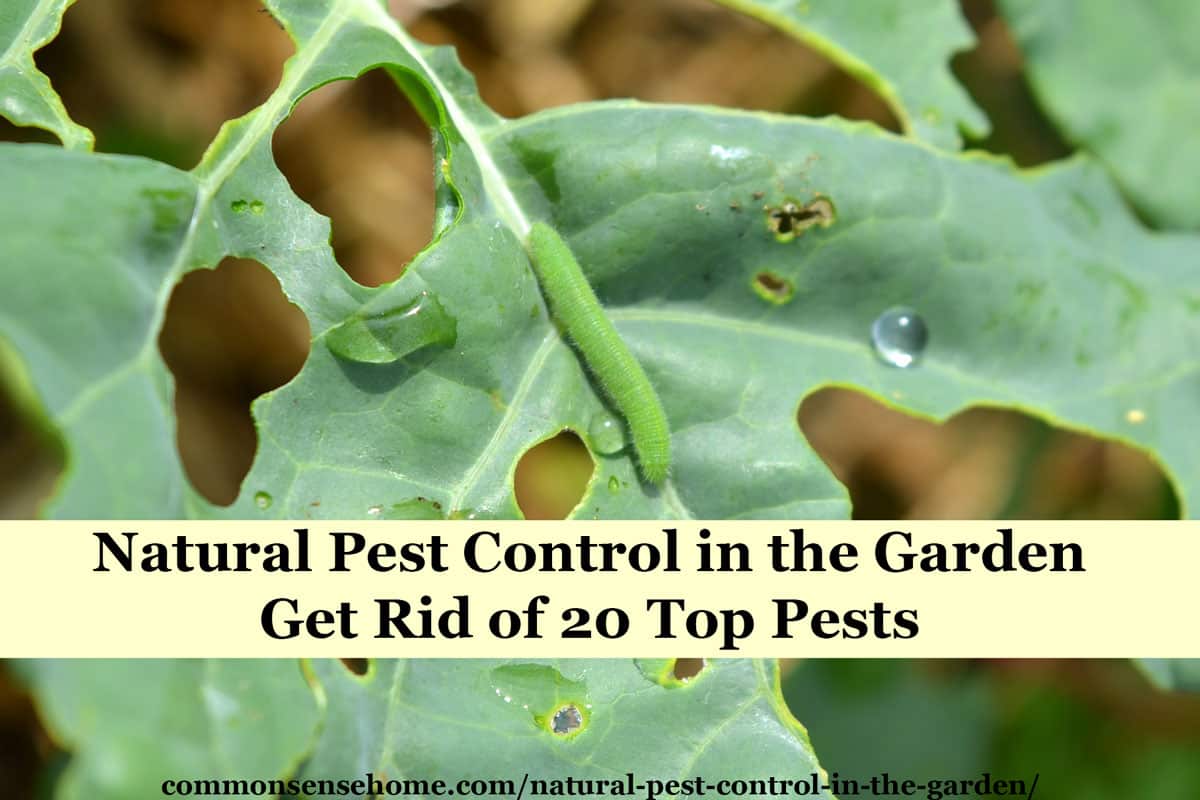
Table of Contents
- Why Choose Natural Pest Control?
- #1 – Ants
- #2 – Aphids
- #3 – Asparagus beetles
- #4 – Cabbage Worms and Cabbage Loopers
- What is Bt?
- #5 – Colorado potato beetles
- Don’t Forget to Watch for Eggs!
- #6 – Corn Borers, European
- #7 – Cucumber Beetles
- #8 – Cutworms
- #9 – Earwigs
- #10 – Flea Beetles
- #11 – Fruit Flies
- #12 – Grasshoppers
- #13 – Hornworms, Tomato Hornworms
- #14 – June Bugs, June Beetles
- #15 – Mealybugs
- #16 – Mice
- #17 – Rabbits
- #18 – Slugs
- #19 – Squash Bugs
- #20 – Squash Vine Borers
- More Natural Pest Control Tips
Why Choose Natural Pest Control?
Just walking down the chemical isle in the hardware store, i.e., the “garden helper area” or whatever they call it, gives me a headache. Sometimes I buy natural products, but often you can get rid of garden pests with what you have on hand.
The old tip about the best defense being a good offense still stands, too. The healthier your plants, the less likely you are to have serious pest problems.
I also encourage beneficial insects and animals to help get rid of problem bugs.
See Working with Nature and Mycorrhizal Planet for more information on building a healthy garden ecosystem.
The article “Attracting Beneficial Insects” will help you lure allies to your garden.
#1 – Ants
Ants aerate the soil and clean up garden debris. Unless they are seriously disruptive, I leave them alone.
If they are in a particularly bad spot, I encourage them to relocate by repeatedly disrupting the hive with boiling water or other disturbances.
If the ants are farming aphids, getting rid of the aphids may get the ants to move on. Boric acid based products, like Borax mixed with jelly, can also knock out a hive.
For more detailed information on ant control, see “How to Get Rid of Ants Naturally”.
#2 – Aphids
Aphids suck the juices out of plants. If plants are stressed and weak, and aphid attack may kill them. Aphids can also spread papaya ringspot virus. Strong plants can withstand a fair amount of aphid attack with little harm.
Many beneficial insects munch on aphids, including lady beetle larva, small wasps, syrphid fly larva and lacewings.
For mild aphid attacks, try hosing the plant off with a strong jet of water. For more heavy infestation, mix up a batch of home pest control spray. (Get the recipes here.)
#3 – Asparagus beetles
These small orange and black beetles move into your asparagus patch and leave chew marks all over the spears. The larvae head underground in fall to pupate and emerge the next spring, starting the cycle all over again.
Hand pick asparagus beetles in early morning when they are cooler and less active. Encourage wild birds, frogs and snakes to visit your asparagus patch with perches, cover and water nearby.
If you have chickens, ducks or other poultry, you may want to allow them into the patch for a short time in fall to clean up the larva. (Be careful with chickens. Too much digging will kill your asparagus crowns.)
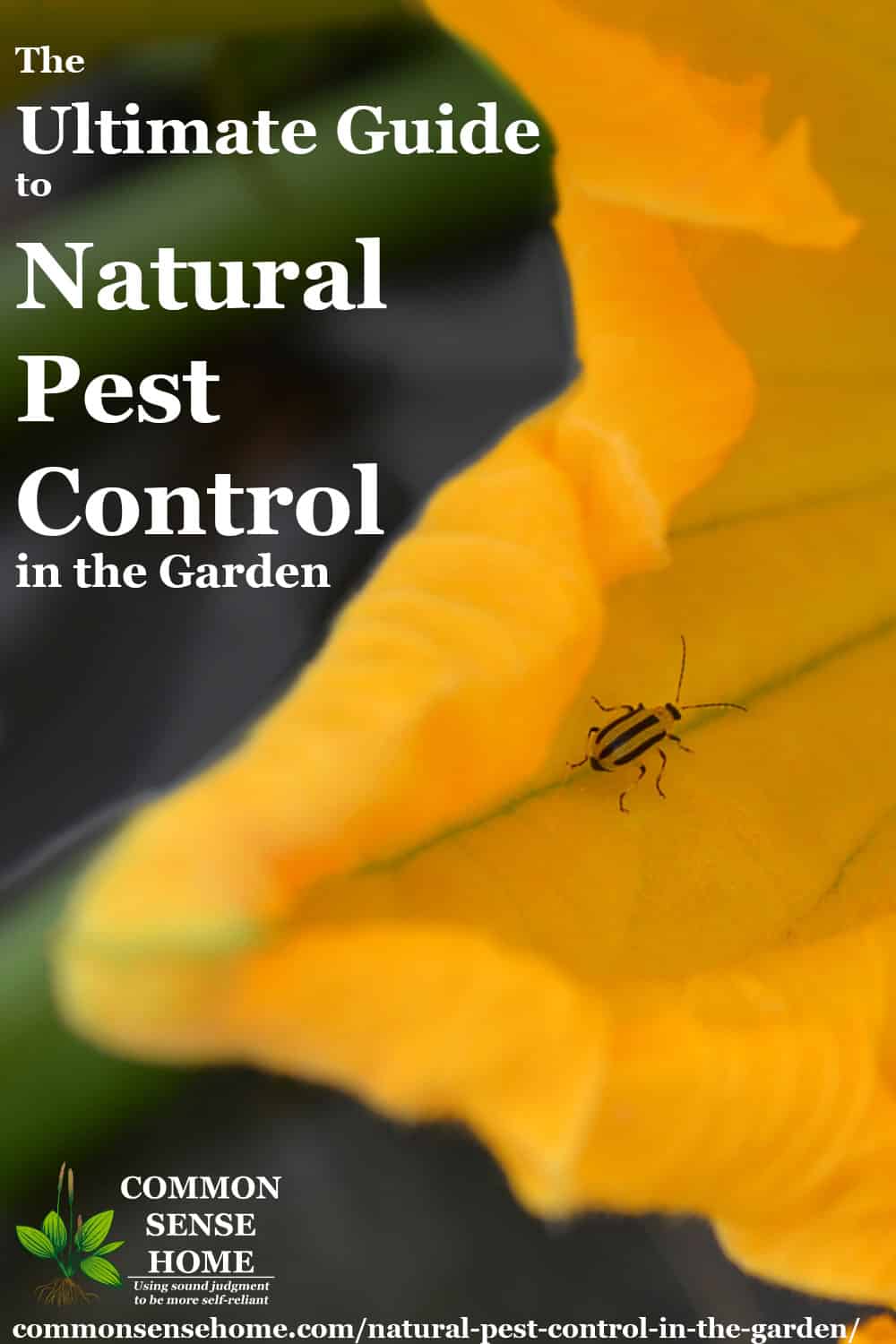
#4 – Cabbage Worms and Cabbage Loopers
These small green worms are both moth larva. Cabbage worms mature into white moths, which are called cabbage butterflies because they are active during the day. Cabbage loopers mature into a dabbled brown moth.
Both larvae are bright green, blending perfectly against the cabbage family plants they like to munch. Sometimes you spot the little dark green piles of worm poo before you spot the worms themselves.
Their eggs are orange-yellow, and are often found on the undersides of leaves. Hand pick cabbage worms or loopers every couple of days to keep numbers in check.
If cabbage worms have gotten out of control, DE (diatomaceous earth) and Bt (bacillus thuringiensis) are two effective natural products that will slow them down.
DE is made of finely ground rock containing the fossilized shells of diatoms. The grains are very sharp, and injure soft bodied critters. (Be careful not to breath diatomaceous earth.)
To catch any cabbage worms you miss before they get to the table, check out “The Easiest Way to Get Worms Out of Broccoli“.
What is Bt?
Bt is a form of naturally occurring bacteria that effects the larva stage of insects, basically causing their stomachs to explode. Because of its overuse in genetically modified crops (the Bt gene is spliced into a crop such as corn so the entire plant becomes a pesticide – see Bt Corn), many insects are becoming resistant to these bacteria. (There are multiple strains of Bt).
Growing cabbage family plants early or late in the season usually reduces insect pressure. These crops prefer cool temps. A light frost won’t harm them, but it will knock down the bug numbers.
Cabbage worms, like most insect pests, will show up in much greater numbers when your plants are stressed in any way. When I’ve accidentally planted them too close together so they are overcrowded, or dealt with drought or poor soil, my cabbage worm problems have been much worse.
Make sure cabbage family plants have ample room to grow (plant 2-3 feet on center) and give them plenty of nitrogen in the form of compost or rotten manure. It’s hard to have soil that’s too rich for these plants.
When your soil is good and your plants are healthy, damage is minimal and plants recover easily. You can also fertilize with fish emulsion, weed tea or compost tea to give plants an extra boost of nutrition.
#5 – Colorado potato beetles
I vividly remember the first time my small suburban garden was attacked by potato beetles. One day the potato patch looked fine. A couple days later, the plants were chewed to lace. (This is another good reminder to check your garden daily if possible, to catch problems quickly.)
I didn’t know what Colorado potato beetle larva looked like, so I didn’t realize the plants were infested until the damage was severe
Here’s an immature potato beetle.

Here’s a mature potato beetle.
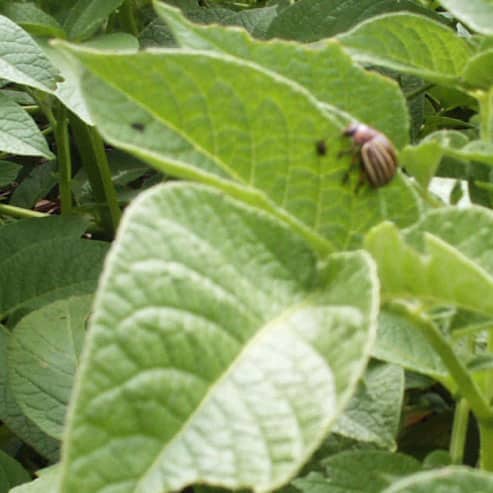
If you can catch these early before they become widespread, hand picking is easy.
To hand pick garden bugs, I prep a large yogurt container or something similar with a couple inches of water in the bottom mixed with some soap to break the surface tension. Knock or drop the bugs into the water to drown.
I don’t recommend squashing mature potato beetles with your bare fingers, as they will bite and their shells are quite hard.
I have also used DE (diatomaceous earth) for potato beetles, but hand picking is my preferred tactic.
Don’t Forget to Watch for Eggs!
Make sure to check on the underside of leaves for clusters of bright orange eggs, and smash them or scrape them into your soapy water.
The boys used to make extra cash in the summer by acting as “bounty hunters” and earning a set amount per bug collected. You can also buy insecticidal soap specifically designed to be sprayed directly on bugs.
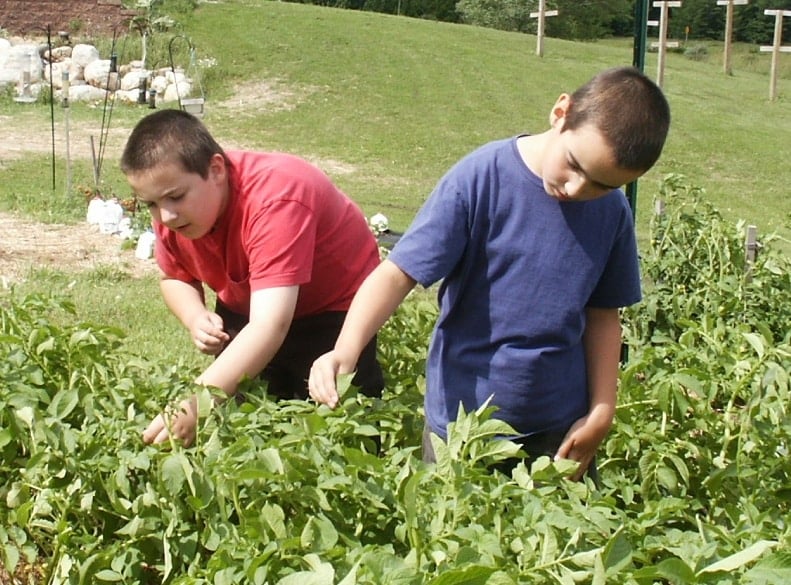
If you can get it, use straw much on your potatoes in addition to mounding them with soil. Barbara Pleasant notes in The Gardener’s Bug Book that straw reduces potato beetle damage by about half.
Floating row covers can work for small patches – just make sure you don’t trap any beetles under the cover.
#6 – Corn Borers, European
If you’ve raised sweet corn in the garden, you’ve likely encountered corn borers. They’re about an inch long, and commonly found at the tip of the corn cob.
Some corn varieties are genetically engineered to include Bt toxins to kill the borers, but borers are becoming resistant. Other corn varieties have naturally tight openings to the husks or thicker husks, which acts as a natural pest control to keep the borers out.
Cold winters and cool wet starts to summers keep their numbers down, as do heavy rains, which knock off eggs before they hatch.
Bt may be effective – if you can get it on the corn the borer is eating. Not easy when they are under the husk. We encourage birds and beneficial insects that hunt them, and trim off any corn borer damage we find at harvest.
#7 – Cucumber Beetles
Cucumbers beetles can do a fair amount of damage, plus they spread bacterial wilt. Bacterial wilt is a disease that gets in the soil. It can cause problems for years after the initial infestation.
Work to maximize your soil fertility. Better soil equals plants that are less likely to attract pests and are more resistant when they attack.
Striped cucumber beetles have yellow and black stripes. They chew up the plants above-ground, and then lay eggs in the soil at the base of the plants. The larvae then chew up the roots. (Dirty devils…)
Spotted cucumber beetles are slightly larger, and will also chew up your vine crops, but they like to lay their eggs near corn. Their larvae are known as corn rootworms.
At our old place, where we had poor, heavy clay soil, once the cucumber beetles showed up, and the bacterial wilt spread, I was not able to grow vine crops well again.
Here, the cucumber beetles show up, but they don’t do much damage. Here I have a mixed clay/sand/loam and much more organic matter.
To control cucumber beetles, it’s best to get them early in the morning, when they are cooler and less active. They like to gather in blossoms, so I will gently shake a blossom into my container of soapy water, or use something like a popsicle stick to scoop them into the water.
Sunflowers are great for attracting cucumber beetles – they love them! They gather on the sunflower heads and I shake them/brush them from the sunflower into the soapy water. This is one of the fastest ways to wipe out cucumber beetles.
For small plantings, you can protect them with floating row covers. Non-bitter cucumbers may attract fewer cucumber beetles than other varieties.
#8 – Cutworms
To me, it seems like adding insult to injury when a cutworm kills a plant by cutting it off at ground level, leaving the rest of the plant to die. When we first put in our garden, I had a lot more trouble with cutworms. Now it’s rare that we’ll lose a plant.
When you switch an area from grass to garden, cutworms are more adundant. Once you cultivate the soil for a few years and root them out as you see them, the populations go down.
Spot a dingy grey grub-like caterpillar about an inch and a half long while digging? That’s probably a cutworm – which you may want to relocate to chicken food.
To protect young seedlings, stick a twig snugly against the stem of the young plant. The cutworm’s “grip of death” is interrupted by the stick.
Another option is an empty can with the bottom cut out placed over the top of the seedling. Be careful not to trap a cutworm inside the can.
Natural predators of cutworms include braconid wasps, tachinid flies and ground beetles.
#9 – Earwigs
Earwigs are a little creepy to me because of their pincers. In the garden, they can be good and bad. They eat aphids, but they also chew on young seedlings.
Would you like to save this?
To reduce earwig populations, try traps. Place rolled up newspapers or hollow bamboo sticks in the infested area. In the morning, dump all earwigs that took cover in the newspaper or bamboo into a bucket of soapy water.
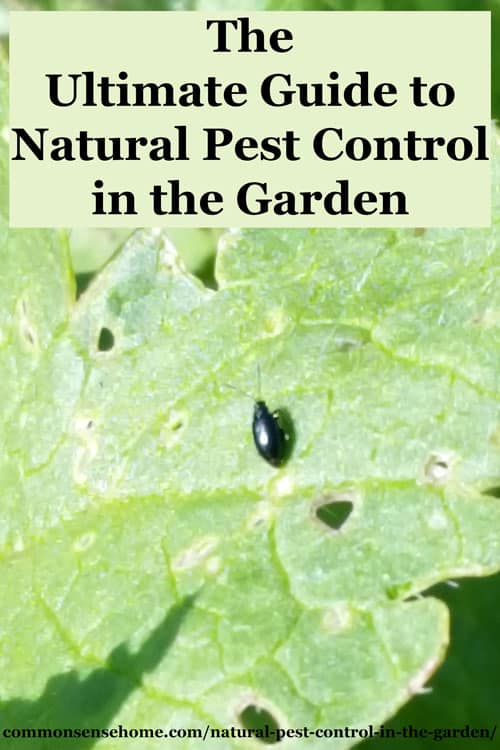
#10 – Flea Beetles
If you end up with leaves that look like they’ve been sprayed with buckshot, and you see tiny, fast moving black bugs, odds are you have flea beetles.
In my garden, flea beetles like to go after early spring growth. Beans and peppers are often hit particularly hard, brassicas get some damage but not as much. Radish greens almost always show some damage.
My preferred natural pest control for flea beetles is coffee grounds.
Apply coffee grounds after damage is spotted to give the plants a chance to recover. (I’ve brought nearly dead plants back from the brink.)
To prevent damage, sprinkle grounds around the plants as they emerge from the soil.
Around mid-winter I start saving up grounds and ask friends to start saving them as well.
#11 – Fruit Flies
There are many different species of fruit flies. They lay their eggs in fruit, and the maggots hatch and chew their way around inside.
For natural pest control of fruit flies in the garden, try tangle traps, which catch the flies in sticky bait.
Inside, make sure to promptly use ripe fruit. Nothing triggers a fruit fly population explosion faster than a piece of rotting fruit hiding in the bottom of a container.
My preferred homemade fruit fly trap option is homemade apple cider vinegar in a small container.
I put a drop of dish soap on the top of the vinegar to reduce surface tension, and cover the container with a piece of plastic wrap with a hole in it. Fruit flies go in in to the container and drown.
See How to Get Rid of Fruit Flies for more control tips.
#12 – Grasshoppers
Thankfully here in northeast Wisconsin, we haven’t had a huge grasshopper invasion while I’ve been gardening. In many areas, they hit like a biblical plague, wiping out anything green.
Grasshoppers lay eggs in the soil, which hatch in the springtime, spread out and EAT ALMOST EVERYTHING.
Floating row covers can be used to protect small areas, but this is one garden pest that is best controlled permaculture style. What do I mean by that?
Think of the grasshopper plague not as too many grasshoppers, but as a lack of things to eat them. Ducks and chickens eat grasshoppers, and have a great time doing it.
See “Duck Pest Control” for more on using ducks in the garden.
No poultry? Try and hunt the largest hoppers in August to keep them from laying eggs. Give them the soapy water treatment, use them for fish bait, or eat them like my friend, Paul.
#13 – Hornworms, Tomato Hornworms
These huge caterpillars can munch their way through a tomato plant at record speed. While these garden pests can do a ton of damage, the hornworms do pupate into beautiful hummingbirds moths.
Hand picking is the most reliable control method. Chickens and ducks love hornworms.
If you spot a hornworm with little white cocoons on its back, the hornworm is under attack from braconid wasps and will eventually die.
Consider keeping it on a spare tomato plant, or in a jar with some tomato leaves to munch on, until the wasp babies have time to emerge.
Hornworms overwinter in the ground in 1-2 inch long dark brown pupae. Fall cultivation will help expose these to the elements and birds. Alternatively, put the chickens to work on garden clean up duty.
#14 – June Bugs, June Beetles
Come June, it’s time for the nighttime ritual thumping of these large beetles against window screens everywhere. The larvae of June bugs are large white grubs, with a preferred diet of grass roots.
They’re a favorite food of skunks, which root them out of your lawn. Since corn is a grass, you’ll sometimes find the grubs chewing at your corn roots, too.
Adult June bugs are attracted to light traps (bug zappers). They can also be hand picked from window screens and given the soap bucket treatment.
For long term control, inoculate the soil with milky spore disease. Milky spore also kills Japanese beetle larvae.
#15 – Mealybugs
I’d never heard of these garden bugs until a reader requested help for their jasmine tree. The small white bugs are fond of tropical houseplants, citrus and other fruits.
For mealybug control in the garden, try a strong blast of water, followed by insecticidal soap.
#16 – Mice
In my garden, my cats and local fox snakes eat the mice. You need to remove the mice or barricade your plants to prevent damage.
To keep mice away from a plant (or plants), you must use very fine mesh fencing – 1/4 inch or less is preferred. If a mouse can get its head through, the body will go through as well. I usually use fencing around individual plants such as blueberries.
Minimize brush piles or other easy cover near the garden. They also like to move into compost bins (especially in winter, when the heat keeps them nice and warm). Wood piles are another favorite hiding spot.
Traps and poisons are other options, but always be aware of other animals, pets or small children that may also encounter these items.
I don’t put out mouse bait anymore since the cats moved in, as I wouldn’t want my kitties eating a mouse that had eaten poison.
The article The Best Ways to get Rid of Mice From Your Home and Garage provides more detailed information on mice and their habits and abilities and keeping them under control.
#17 – Rabbits
The first year I planted, the wild bunnies did a number on my freshly sown peas and other tender greens. I didn’t want to fence everything, because it makes it more difficult to tend to, plus fences don’t always keep bunnies out, so I had to come up with another solution.
I tried the spray on Liquid Fence products, and they worked – until it rained. They were also expensive.
I tried cayenne pepper, which worked until the rain washed it off, but also burnt the plants where I had applied it a little too heavily. (Essential oil sprays have the same issue.)
My best solution for protecting my plants from rabbits is to mulch them heavily with strongly scented herbs.
I have volunteer catnip and lemon balm all over the place, which the bunnies don’t bother at all. I cut bundles of these and other strongly scented herbs, and snuggle them up around newly emerging seedlings.
This keeps the bunnies at bay until the plants are strong enough to withstand a little nibbling. The herbs don’t wash away in the rain, and the protection lasts for weeks.
#18 – Slugs
We get a lot of wind, so I mulch heavily to keep the soil from blowing away and to retain moisture. Last year we had a cold, wet spring, which led to a boom in the slug population.
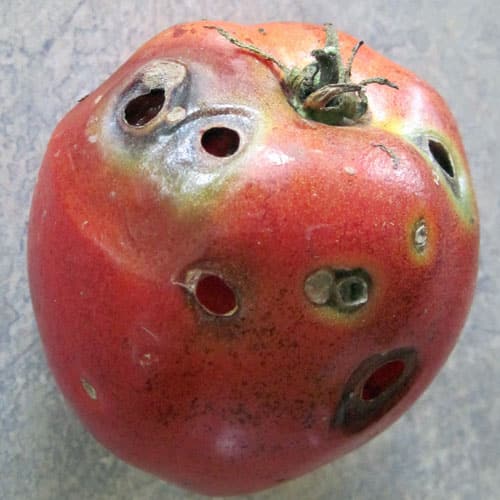
I tried beer traps. I took a sour cream container, buried it up to the edge in dirt, and put about an inch of beer in the bottom. It cleared out the area, and then I didn’t catch anymore.
I think you’d need a lot of these to catch all the slugs, plus, one of the traps got dug up and something drank the beer! Natural pest control that attracts drunken varmints creates new problems.
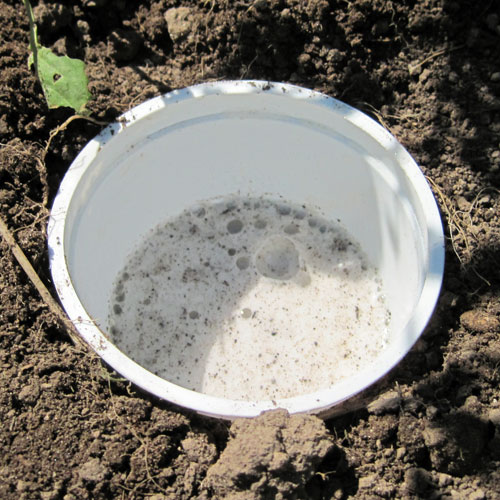
The best option for slug control I’ve found is ducks!
Ducks don’t dig up your garden like chickens, and they LOVE slugs. They can even eat big banana slugs. Our small flock of five runner ducks has made an amazing difference in our garden.
The second best option is diatomaceous earth (DE) or crushed eggshells.
Eggshells are generally free, and you’re not likely to inhale much dust from them, unlike the DE. Apply crushed eggshells generously on the soil surface wherever you have slug troubles.
#19 – Squash Bugs
Squash bugs are fast moving and breed rapidly. The adults resemble stink bugs (some of which are beneficial) so when they first showed up in my garden, I didn’t realize they were trouble.
I soon learned the error of my ways. Squash bugs can suck and chew a plant to death in days. Look for egg clusters on the underside of leaves and smash them or scrape them into your soapy water.
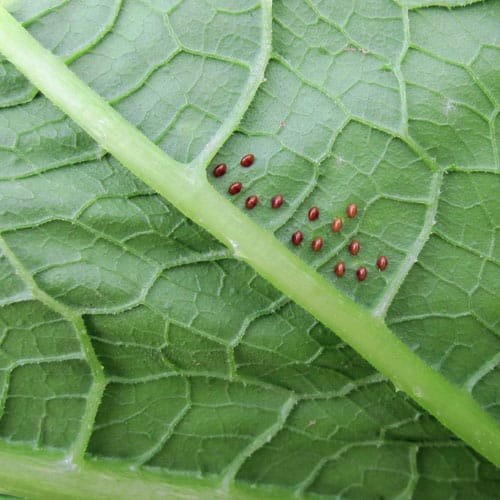
Treat squash bug nymphs the same way.
Neem oil is supposed to be effective on the nymphs if they are hit directly, but it didn’t slow the ones in my garden down very well. Another option is to wrap a strip of duck tape around your hand, and press it against the eggs to lift them gently away from the leaf. You can use the tape to nab the nymphs, too.
For more options, see “How to Get Rid of Squash Bugs“.
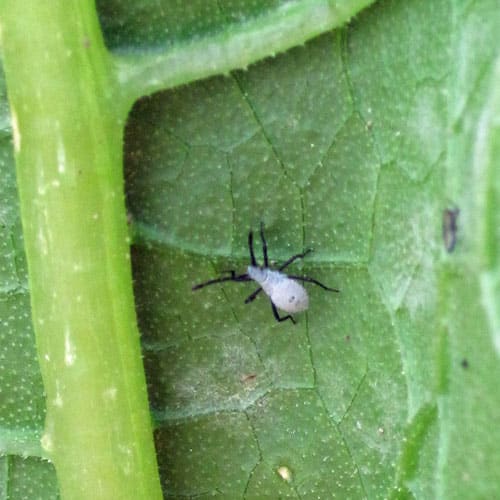
I’ve recently started researching entomophagy (eating bugs), and found out that squash bugs and many other common garden pests are edible.
For those who are interested in turning natural pest control into lunch, you can read Eating Bugs – Free Food from Your Backyard.
#20 – Squash Vine Borers
If you find holes in a squash stem that have a pile of what looks like sawdust next to them, you likely have squash vine borers.
When I have clear borer signs, I carefully slice open the stem and remove the problem insect larva. After removal, I bury the stem in compost or rotten manure to encourage additional roots. (Mulching the vines may also deter further attacks.)
Keeping your squash vines covered until female blossoms show up will help keep your plants clear of borers. Cucurbita moschata varieties, such as butternut squash and Tromboncinos, are highly resistant to squash vine borers.
More Natural Pest Control Tips
These are my primary methods of natural pest control in the garden. For more information, I highly recommend “The Gardener’s Bug Book“.
Related posts you may also find helpful:
- 6 Ways to Use Garlic in the Garden
- Keep Deer Out of Your Garden – 5 Deer Deterrent Strategies
- Natural Ways to Repel Mosquitoes
- How to Get Rid of Fleas (Non-Toxic, Pet Safe Options)
- Keep Biting Flies Away
Do you have a tip you’d like to share, or a pest that’s causing trouble? Leave a comment and let me know, and don’t forget to hit “Like” or otherwise share this post if you find it useful. 🙂
Originally posted in 2012, last updated in 2020.

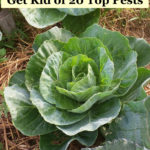
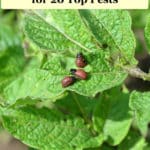
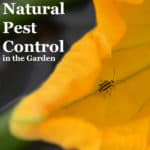
Thanks for these helpful comments. However, no one has so far given the appropriate name to the pesticide or oils or mixture of the controls to use for ants, mites borers, aphids, mildew, bugs, white dusts, etc. What is the best pest controls to purchase for all the above pests. For example: Is peppermint oils together with neem oil OK for pest control and how do you mix the two or other mixtures? Please give some context to what can and cannot be used for pest controls. Thanks.
I don’t recommend randomly spraying everything with pesticide, because I think it’s a bad idea to spray everything with pesticide. Even “natural” pesticides kill beneficial insects right along with the pests.
If you want to use neem oil for killing bugs, mix according to package directions. I don’t advise mixing pesticides. Use the minimum amount possible to get the job done.
Years ago, I tried an assortment of different types of pesticide sprays. Unless you spray directly on the bugs, they often have little effect, or you have to use so much you kill off the good bugs, too.
That’s why I now recommend very specific powders and mechanical controls, and working to improve the health of your plants. All of these are much more reliable than pesticide sprays, and don’t cause unintentional harm.
when I was growing up the old farmers told me that the best defense against cut worms were lighting bugs… they eat the cutworms.
I know this article is old but I appreciated it, especially the part about payback. That’s crazy! Thanks for the LOL!
Old, but recently updated, and I do still check comments on all posts, no matter what the age. I’m glad you enjoyed it.
Hi – I am a novice vegetable gardener and newer still to organic gardening. Last year I bought some really high quality compost. The problem is that the Fire Ant Love, Love, Love it. This summer I skipped planting a summer crop because they were so bad. I need to kill them if I am to plant the fall crops. Please help. I have an investment in building all these elevated raised beds. Thanks in advance.
There are some ideas for ants in the post “How to Get Rid of Ants Naturally“. I’m not sure how well they will work on fire ants, but it’s worth a shot.
Dust/sprinkle whole area of garden, plus a good ten foot perimeter around garden with reg corn meal. Ants cant digest it. They explode. It may take a couple weeks or so. Or maybe. A couple treatments, if you were cheep on corn meal.
For inported fire ants use a single packet of Splenda, poured on top of hill ! Then, run !!! like the devil was after you.
????????????
I’ve tried the corn meal . . . the fire ants laughed at it. I will try the Splenda . . .funny how you said to run like the devil was after you. I also heard an Orange oil and soap drench will work on fire ants. I am going to give THEM the devil! Thanks for your suggestions.
Ann-Marie : Howdy ????
I just just now stumdled on your response to me. I guess i need to regestar to site.
Friend in Geogia told me in same words. She can be found on garden.org site. Her handle is @greene my handle is @philipwonel
Its a good site also. You can send either one of us a private Tree Mail there. ????
I said run like the devil, because, them imported fire ants are gonna be mad and swarm when you dump that splenda on there nest. I don’t care to be to close.
Bye Philip ????????????
At the first sign of aphids on my tomatoes I purchased 1500 ladybug beetles from my garden center. We were only told to release them in the cool of the day. I did this in the a.m. and they immediately flew over the fence to my neighbor’s garden. Read internet instructions which include releasing 50 “scouts” AFTER wetting the tomato (or other) foliage at dusk. Then two hours later release the rest. The wet leaves apparently give them traction and the scouts lead them to the diseased leaves. If they don’t have enough “food” to eat, they will leave. I believe that was also part of my problem,
Thanks for sharing your experience, even though it didn’t work out as planned. Hopefully you’ll help someone else avoid the same issue. I’ve never tried purchasing predators, since we have so many that just show up.
For snails and slugs i use dry oatmeal. They love it. It swells and ! Blows them up !
Ha ha !!!
For ants a dusting of corn meal/grits over entire garden plus 10 foot around perimeter. Takes care of ant for entire season. Ants eat it, and cant digest it. Ha ha ! Again !!!
????????????
Thanks for sharing your experience, Philip. This post is in need up updating, so I’ll make sure to include your tips.
I had an infestation of earwigs last summer. What can I do?
Earwigs like to dine on decaying organic matter – but sometimes take to munching on garden plants as well.They also eat aphids, mites and nematodes, so they aren’t all bad. If you have a lot of dead plant material in the garden, it may be helpful to gather that and compost it to reduce earwig habitat.
If your earwig is out of control, consider trapping. You can do a variation of slug traps, with a shallow bowl of oil set into the ground (sardine can juice works great), but that way attract other unwanted visitors. (My slug beer traps brought in a drunken raccoon or possum.) Another alternative is using a rolled up newspaper. Pick it up in the morning and burn it or shake the hiding earwigs into some soapy water. if earwigs are heavy on a particular plant, put a towel below the plant, shake them onto the towel and dump them in the soapy water.
You can also bring in tachinid flies, which feed on earwigs, by planting alyssum, calendula, dill and fennel.
I finally found a way to keep earwigs out of the house. They can be beneficial outside although they will eat many things in your garden too. I personally think they are too creepy. All of the above is good information. Here is a preventative weapon: take a quart jar, put 2TBS of Dawn, 1 TBS of oil (like olive oil) and 4 or 6 cloves of garlic. Fill with water. Let it sit for a couple of days. I put this liquid in a bottle and spray or pour around the perimeter of the house. It doesn’t kill them but they hate it and will stay away.
Coffee works on squash bugs. I run a second pot through used grounds and when it cools put it in a sprayer. Spray the underside of the leaves and the base of the plants to reduce the number of nymphs.
Thanks for the tip. I hadn’t heard of that one.
For the flea beetles, are you applying the coffee grounds to the plant or around the plant? Last year they started on our potatoes and proceed to move around the garden like a buffet .
I have always put my coffee grounds in the compost so I was just wondering what your application was.
Thanks again for your informative website.
We are planting green beans following your directions. 15 ft. double row with Filet Emerite seeds.
I have always grown pole beans but had been wanting to try a new variety.
I think I was linked over here from the “Natural Garden Pest Control” on that page..
I sprinkle the coffee grounds on and around the plant. You wouldn’t want to bury the plant entirely, but a light dusting is great if you can get it.
Just found your website and love it! Moved to central Indiana two years ago and have a love acre of land to tend a garden. So much fun and lots of work but worth it. Trying to do all organic as grandchildren run through garden eating fresh kale and sugar snap peas, etc. What a joy.
However, I lost a lot to the squash bug last year, even though I daily went out and picked off the eggs and watched as the nymphs quickly jumped off when they saw me coming with my pail of soapy water. Once they destroyed all the zucchini, they went on to bigger and better things, like tomatoes and anything else they can find. I understand Neem Oil messes with their nervous system and even though it doesn’t kill them immediately, they forgot to drink and eat and die. I read you have tried Neem without a lot of luck and now do hand picking which is what I tried last year. Any other ideas? Thanks as that is really the only pest I have had major issues with and I’m afraid they will be back!!!
One thing I read about since this post was written was using duct tape to remove the eggs and nymphs from the leaves. It’s still labor intensive, but would be easier than scraping. Just wrap the tape sticky side out around your hand. The adult squash bugs are not very impressed by neem. Soapy water or the hand vac still seem to provide the best defense, and fertilizing the beejeezus out of the plants so they are strong enough to withstand attack.
We use eggshells. I put some around all the young plants–slugs and snails (and probably other soft bodied bugs) can’t get past the crushed up eggshells. I also use them around the edges of the boxes and around anything that’s subject to snail damage. It has the added benefit of putting extra calcium into the soil.
I also use a dilution of vinegar with hot peppers on squash bugs, etc. It works very well if you catch them when they’re young–not so much on the adults, although they don’t like it and they’ll usually go elsewhere. If you catch the infestations early one or two applications should be sufficient. If the infestation is further along, you may need to do it every day for a few weeks. Be careful though–the liquid is corrosive, so you don’t want to use it for an extended period on anything really fragile.
Thanks for sharing what works in your garden.
have you tried D.E. ( dimatamatous earth ) i bought a bag and i am very excitied about trying it, and was wondering if anyone else has tried it and what kind of success if any you had
Yes, I mention using it in the post for soft bodied critters. Just be careful not to breath it.
Awesome stuff.if its OK I’m gonna use the pancake recipe forever.passing it down through my kids.etc.now I’m going to try haluska.I’m very thankful for all the gardening tips.
This year the squash bugs & the cabbage worms got ahead of me when the rain set in. Fortunately, I have big beds of lemon balm, mint, and some tansy. I made herb tea concentrate from an armload of herbs; then strained it into an empty, clean plastic jug to store. In my quart spray bottle, I placed 4 drops of dish detergent, 1/4 cup vinegar, 2 t. cooking oil, and topped it off with herb tea concentrate. I saturated bottom side of cabbage leaves first then sprayed the tops of the leaves & the head. Walked on over to the squashes and saturated the stems and the soil, then sprayed both sides of the leaves and removed the eggs. In 2 days there was only an occasional squash bug or cabbage worm. So I wanted to discourage the remaining threat and looked to my pantry. I found “OLD” spices and used several T. of cinnamon, chili powder, ginger, cayenne & baking soda + t. of clove & allspice. I placed the mixture in an empty spice sprinkler jar and happily sprinkled edible dust on my squash & cucumber & melon stems, then sprinkled the bottom of the leaves and the top of the leaves.
It has been over a week and 2 rains since I tag-teamed the bugs with strong mint spray and next day with powdered spices. I picked 7 summer squashes today & saw NO sign of squash bugs. The cabbages/broccoli have no new holes in their leaves & have resumed growing. It’s FUN to monitor this change in my garden.
Very cool! Thanks for sharing.
Thanks for the tips! Fortunately, the birds haven’t found our berries yet (we’ve had them a few years), but we are always worried they will.
What if you don’t want birds in your garden because they will steal all your berries? Can I encourage frogs without encouraging birds?
Skip the perches and the bird feeders, and keep the water shallow and on the ground. Unfortunately, berry eating birds know a good thing when they see it, and netting or berry painted rocks may be needed to preserve your harvest.
True eastern yellow jackets and german wasps are virulent, especially in hot weather. They build their nests low to the ground, or even in the ground. They seem to launch sneak attacks on me every year. I don’t wear any scent, I don’t wear bright colors, but they are intent on finding me. I’m in Door County, WI. Thanks for reponding.
Thanks for pointing out what I missed.
When I get stung or bitten by insects, yellowjackets, etc., I run for my comfrey plant, smash up a leave until I get the juice running (or it can be chewed for a minute and then put on as a poultice), and I have found the bite goes away very quickly. Comfrey is something I would never be without in my yard, and it is very good for your health, as well, so any that is ingested is a plus.
Comfrey is also a great bioaccumulator and makes a good garden compost or drop mulch.
Give me cabbage worms any day, over yellow jackets! I’ve been thinking about responding to your post for days. Every year I get stung repeatedly and have developed a severe local allergic reaction. Every time, I suffer intense swelling. The 8 devils that got me last Friday while weeding my raised veggie beds kept me off my feet for 2 days due to swelling. Let’s put the cabbage worm vs. yellow jacket discussion into perspective, and not call yellow jackets “beneficial”. Although technically beneficial because they eat pest insects, yellowjackets are responsible for almost all of the so-called ‘bee sting deaths’ in the United States. Since I am too sensitive to get rid of the nest on my own, I spent $110 today to have an organic pest control service get rid of this latest nest. I love your site but please don’t encourage people to disregard the dangers of these beasts.
Kathi – I appreciate your input, and thank you for taking the time to think about your response and not just lashing out in anger as some might have been tempted to do. I’m not sure what part of the country you’re in – maybe you’ve got more aggressive bugs than we do? Maybe mine are unusually docile? In all honestly, I’ve never been stung by our yellowjackets, even when I knocked nests out of the greenhouse and off the deck, or when I’ve bumped into them in the garden, or when I brushed into the nest they had built on the deck railing with my hand. The only time any of us have been stung here is when my son had one stuck inside his shirt. I got stung some years ago at a sidewalk sale, and my eldest was stung outside a hardware store. I work around the bees, yellowjackets and wasps all the time. Just to be on the safe side, I’ll add a note in the post about your concerns.
Kathi, the next time you get stung by one of those yellow-jackets put a slice of raw potatoe on it. It won’t keep it from hurting but will keep you from swelling. I have the same problem of swelling, this works.
Do you have any experience/suggestions for dealing with pill bugs? I called them roly polys when I was growing up, but now they are my archnemesis, and that cute name doesn’t fit. I made the mistake of mulching with plain ol’ oak leaves, gathered from a corner of the yard where they’d been falling and piling up/composting for years. They were, apparently FULL of bugs. I am almost certain they are the culprits munching my plants’ leaves and occasionally stems. I put out beer traps and caught quite a few, but it was a small fraction of the horde.
Normally the pill bugs will focus on decaying matter (like the leaves), but can cause damage to living plants. In the gardening forum discussion, people had success with beer traps and Sluggo. (http://forums2.gardenweb.com/forums/load/organic/msg0517354215184.html?15)
I’d also work to encourage, snakes, frogs, toads, lizards – whatever you’ve got that might eat the bugs, and possibly put some fresh decomposing matter nearby if you have space to try and lure them away.
Northwest Arkansas, being part of the south, has not one by two visits from the squash bug hoards. If I can get control the first go round, I can reap a wonderful harvest before they invade again in late summer. You name it, and I have tried it to keep these vermin at bay (or off to squash bug heaven). I talk to everyone I know and they offer the same solutions: get what you can before they devour the plants and pull them up and burn the reside and rotate planting. Right!!! I did have a organic gardening truck farmer friend in Vermont to introduced me to an organic produce called “Pyganic” (not advertising here, just sharing). I used this last year and had a bumper crop all summer long. I was thrilled!!!! I sprayed in the evening so as not to interfer with the bees in the early morning hours. Read the literature before you use and make your own choices. I just have to say using this product is the only time in the last 10 years I have been able to produce a crop of squash that was worth all the work I put into it.
Thanks for your tips and encouragement….
Happy gardening.
AJW
Pyganic is a trade name for a pyrethrin based product, which is a natural insecticide. They are less toxic than many options. “How it works: Pyrethrum is a fast acting contact poison that ‘knocks down’ susceptible insects. Insects are left paralyzed by the toxic effect of pyrethrum. The normal function of the nervous system is affected, stimulating repetitive nerve discharges leading to paralysis. However, some insects are able to recover after the initial knockdown if the dose is too low.” – more here – http://web.pppmb.cals.cornell.edu/resourceguide/mfs/10pyrethrum.php
http://web.pppmb.cals.cornell.edu/resourceguide/mfs/10pyrethrum.php
Also, beware the synthetic knockoffs of natural pyrethrin. See “Synthetic pyrethroid pesticides are cause for concern with a link to serious chronic health problems.” for more information – http://appprecautionaryprinciple.wordpress.com/2011/06/04/synthetic-pyrethroid-pesticides-are-cause-for-concern-with-a-link-to-serious-chronic-health-problems/
I’m glad to hear that you are doing your best to avoid killing your bees while preserving your harvest.
I would disagree that Pyrethrum is a safer pesticide. It is natural; that does not make it safe. It will kill bees. I had a giant nest of yellow jackets (not honey bees) in my basement and this is what they used to get rid of the entire nest. It is very effective.
I do note within the post:
“Remember, a natural pesticide is still a pesticide. Always use pest control, even organic pest control, mindfully and selectively.”
Thanks for linking your great post to FAT TUESDAY. This was very interesting! Hope to see you next week!
Be sure to visit RealFoodForager.com on Sunday for Sunday Snippets – your post from Fat Tuesday may be featured there!
http://realfoodforager.com/fat-tuesday-february-14-2012/
What a wonderful post! Lots of great tips here. Last year I had a bad attack of cucumber beetle, which killed my cukes, squashes and watermelons overnight. I’ve read they lay eggs in the soil and that means I’ll have a worse infestation than last year. Any ideas what to do? They are pretty fast and impossible to catch and pick off. Once the squashes and melons were dead, they attacked the flowers on the okra, so I got nothing from that, either.
Ilene – Cucumbers beetles can be terrible, plus they spread bacterial wilt, which gets in the soil and can cause problems for years after the initial infestation. First off, work to maximize your soil fertility – better soil = plants that are less likely to attract pests and are more resistant when they attack. Annette at Sustainable Eats is launching a soil building challenge right now – http://www.sustainableeats.com/2012/02/09/urban-farm-handbook-february-challenge-soil-building/
At our old place, where we had poor, heavy clay soil, once the cucumber beetles showed up, and the bacterial wilt spread, I was not able to grow vine crops well again. Here, the cucumber beetles show up, but they don’t do much damage. I’ve got a mixed clay/sand/loam and much more organic matter.
To control cucumber beetles, it’s best to get them early in the morning, when they are cooler and less active. They like to gather in blossoms, so I will gently shake a blossom into my container of soapy water, or use something like a popsicle stick to scoop them into the water. Sunflowers are great for attracting cucumber beetles – they love them! They gather on the sunflower heads and I shake them/brush them from the head into the soapy water. You can eliminate large qualities of them very quickly. The sunflower trap works almost any time of day.
I use a small shop vac to catch bugs in ny garden. A dust buster would be handy
Have you ever tried Diatomaceous earth? I here it works great for slugs and ants.
Brittany – yes, I sometimes use DE for slugs and other soft bodied critters.
Hi! I love your blog and I would like to recognize you by awarding your blog the Versatile Blogger Award!
If you would like to accept it, please go to my blog to receive it here:
http://thepocketfarmer.com
If you do not accept blog awards, please let me know and I will forward it to someone else instead.
Thanks for sharing!
Sue (The Pocket Farmer)
Sue – thank you so much for your thoughtfulness. I’m afraid that I’m up to my eyeballs in alligators, as usual, so it’s really tough to squeeze in time for things like blog awards. It probably would be best if you tag another blog.
I live in SE Texas and we must do battle with all sorts of insects in our gardens. Then there are the squirrels who compete with us for our goodies. 🙂
Sadly, because we are in the suburbs, I have not seen frogs in several years. They used to be everywhere. I hope that they aren’t gone permanently because of pest or herbicides.
You have written a great, informative article, as usual.
You are quickly becoming my favorite blogger.
Thanks!
Carmen – is it dry where you are at? That makes a big difference, too. Glyphosate weed killers (RoundUp) are very hard on amphibians, as are many pesticides, which act as neurotoxins. Even back in the suburbs, where I was surrounded by neighbors who chem treated their lawns, our yard became an oasis. If you build habitat, they will come, if they can. Thank you for your kind words!
Thank you so much for this post. We might be starting a garden this year (if soil testing indicates the prior homeowners lawn chemicals are gone) and I was prepared to shell out big bucks for “organic” pest control. We happen to have DE on hand, and drink lots of coffee.